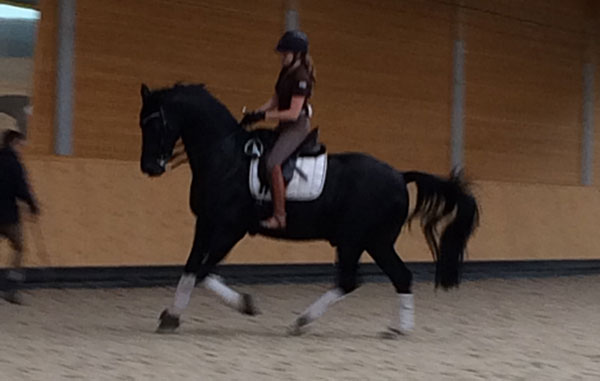Here are some more impressions from the Manuela Keller clinic last weekend at Hof Börnsen…

As I said before, she was very committed to make sure each horse stretched completely long and low before they worked. She made sure the tempo of the trot was not too fast, allowing the horse to balance and swing. If the stretch was tricky, she used simple suppling exercises such as changes of direction until the horse released his back.
For a rider whose hands moved to much, she placed a whip between the riders thumbs. That way, the thumbs stayed on top and the hands were connected to each other, reducing how much they could move. With quieter hands, the rider found other ways to influence the horse, making the seat and leg aids more effective. She paid close attention to how the rider used the leg and differentiated between the hip, the thigh, the calf or the spur.
She completely trusts the system of training. Every horse began at a level where they were comfortable. Then she asked the rider to do a slightly harder movement. For example, a novice rider with a Training or First Level horse learned to ride 10-meter circles. It was difficult but it helped the rider control the bend better and make the horse more supple. When the circle was easier, from the centerline she rode 10-meter circles to the left and right. Beginning at the centerline guaranteed that the circles were not too big, and changing direction helps supple the horse. That same horse was schooling shoulder-in by the end of the second day.
The upper level horses were just as systematic. She made sure the bend and engagement were correct in the shoulder-in and traver before moving to the half-pass. Some horses stiffened in the half-pass, so she went back a step to help supple the horse again. For example, if the horse lost the bend she combined half-passes with 10-meter or 8-meter voltes. She had the riders practice half-pass left, volte left then turned that into a figure eight with a volte right, followed by a half-pass right to work on the zig zag at the trot.
She often went back to traver or renver (haunches-out) to get the bend in the body. At the canter, she did traver on the long side in collected canter, then on the following long side, a change early on then renver at the counter canter, then straighten and change, the traver on the true lead, etc.
When she moved on to the piaffe and passage, her emphasis on the suppleness and bending did not dissipate. She did the half steps on a volte to keep the suppleness. She did transitions between passage and trot then asked for traver or half-pass. She asked for a little passage in the traver position as well.
My overall impression was that she had a whole encyclopedia of movements in her mind, and she put them together for each horse individually and systematically to achieve the best thoroughness and most developed gaits possible. It was inspiring to watch!











